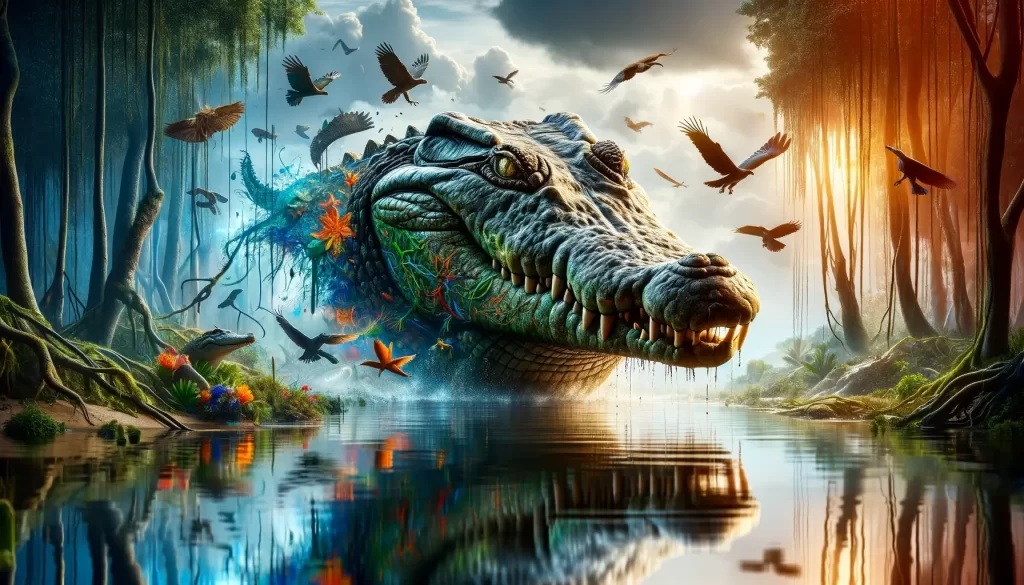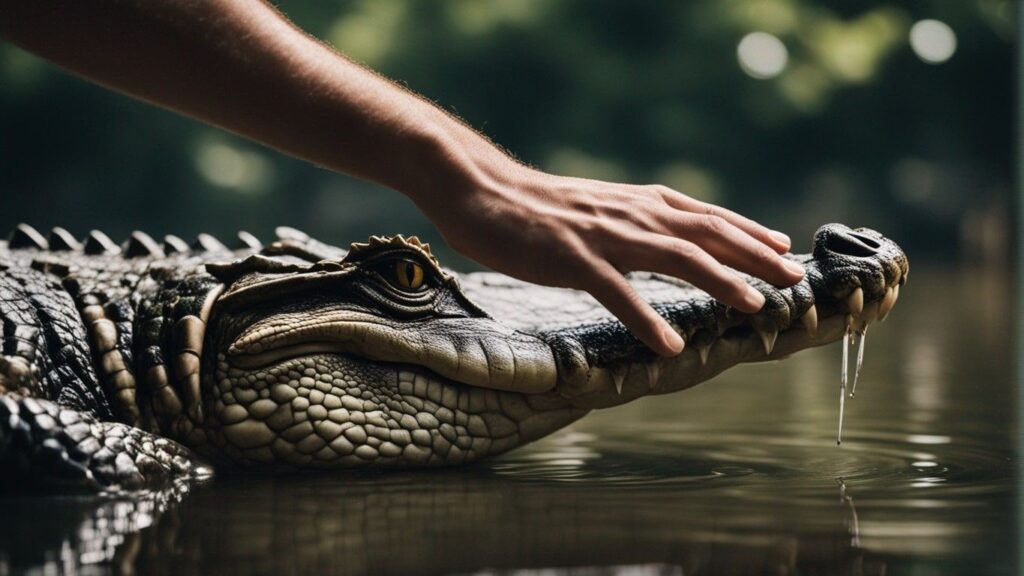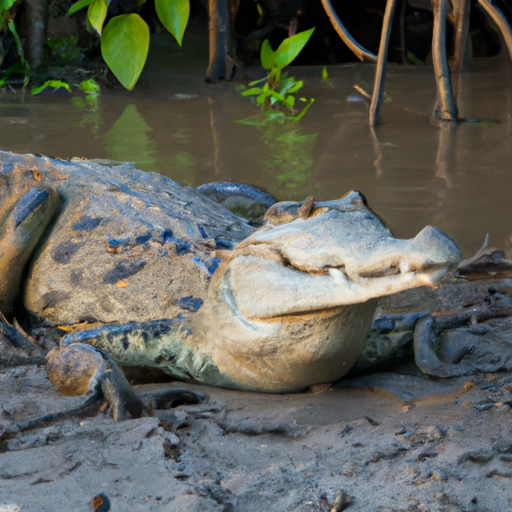
Intriguing and mysterious, crocodiles have long fascinated humans. These magnificent creatures, with their ancient lineage and impressive survival skills, hold significant symbolism and represent various qualities across different cultures and mythologies.
From representing power and resilience to symbolizing patience and stealthiness, crocodiles are seen as both fearsome predators and respected guardians in the natural world.
Let’s explore the diverse interpretations and meanings that crocodiles embody, revealing their rich symbolic significance in different aspects of human life.
Physical Characteristics
Size
Crocodiles are known for their impressive size. Depending on the species, crocodiles can range in length from 5 to 23 feet, with the saltwater crocodile being the largest of them all. These magnificent creatures can weigh up to 1,000 kilograms, making them one of the largest reptiles in the world. Their sheer size commands respect and awe, instilling a sense of admiration for their power and presence in the natural world.
Shape
One of the most recognizable features of a crocodile is its distinct shape. Their long, muscular bodies are well-suited for their semi-aquatic lifestyle. With their short legs, streamlined bodies, and powerful tails, crocodiles are built for both agility in water and stability on land. This shape allows them to swiftly navigate the waters and ambush their prey with precision and ease. Their shape serves as a testament to their adaptability and efficiency as apex predators.
Skin
The skin of a crocodile is truly unique and instantly recognizable. Covered in rough, scaly plates called scutes, their skin provides protection from predators and environmental hazards. These scutes act as a form of armor, guarding the crocodile’s sensitive underbelly. The texture of their skin is a fascinating example of nature’s ingenuity, with its rough and bumpy surface allowing them to seamlessly blend into their surroundings. Additionally, the composition of crocodile skin allows them to retain moisture, making them well-suited for their aquatic habitats.
Symbolism in Different Cultures
Ancient Egypt
In ancient Egypt, crocodiles held great significance and were associated with the Nile River, which was the lifeblood of the civilization. They were revered as powerful and divine creatures, symbolizing fertility and protection. In Egyptian mythology, the crocodile-headed god Sobek was worshipped, believed to have dominion over the Nile’s waters, and seen as a protector of the pharaoh. The crocodile’s presence in Egyptian art and architecture further emphasized its cultural importance.
Australian Aboriginal Culture
For Australian Aboriginal cultures, crocodiles are seen as ancestral beings with spiritual significance. Known as “Garrimala” in some Aboriginal languages, crocodiles are revered as creators of life and important totems for various clans. Their representation in traditional art and storytelling serves as a reminder of the deep connection between Aboriginal people and the natural world, reinforcing the importance of respecting and living in harmony with nature.
Mayan Civilization
In Mayan civilization, crocodiles played a role in religious practices and ceremonies. They were believed to serve as powerful protectors and gatekeepers of the underworld. Mayan artwork frequently depicted crocodiles alongside gods and mythological creatures, showcasing their symbolic prominence within the culture. The Mayans deeply respected the crocodile’s strength, associating it with power and the ability to navigate both land and water effortlessly.
Power and Strength
Survival Instincts
Crocodiles have impressive survival instincts that have allowed them to thrive for millions of years. Their ability to adapt and survive in various environments showcases their resilience as a species. When faced with a threat, crocodiles rely on their acute senses and lightning-fast reflexes to evade danger or confront it head-on. Their powerful survival instincts make them formidable predators and an integral part of their ecosystems.
Ambush Predators
One of the key reasons for the crocodile’s power and strength lies in their hunting strategy. They are skilled ambush predators, lying in wait for their unsuspecting prey to come near the water’s edge. With only their eyes and nostrils visible above the water, crocodiles can remain virtually invisible to potential victims. When the opportunity presents itself, they will swiftly launch themselves out of the water, using their powerful tails to propel them forward and secure their prey with jaw-dropping force.
Jaw Strength
The jaw strength of a crocodile is legendary, capable of exerting immense pressure when delivering a crushing bite. Their jaws are armed with dozens of razor-sharp teeth, allowing them to grip and hold onto their prey with a vice-like grip. Estimates suggest that a crocodile’s bite can exert a force of up to 3,700 pounds per square inch, making it one of the most powerful bites in the animal kingdom. The combination of their immense jaw strength and ferocity makes crocodiles an unparalleled force in the natural world.
Connection to Water
Aquatic Adaptations
Crocodiles have evolved numerous adaptations that allow them to thrive in aquatic environments. Their streamlined bodies, powerful tails, and webbed feet make them excellent swimmers, enabling them to navigate through water with remarkable agility. Additionally, they have specialized glands on their tongues that can excrete excess salt, enabling them to survive in both saltwater and freshwater habitats. These adaptations highlight the crocodile’s deep connection to water and their ability to conquer different aquatic environments.
Dependence on Water
Water is an essential aspect of a crocodile’s life. Not only is it their primary habitat, but water also plays a crucial role in their reproductive cycle. They build large nests near the water’s edge, where the eggs are incubated and protected. Once hatched, the young crocodiles stay near the water, relying on it for protection, shelter, and a source of livelihood. This dependence on water reinforces their close bond with aquatic environments and their status as masters of the waterways.
Navigating Waterways
Crocodiles are masters at navigating waterways, utilizing their unique adaptations and inherent abilities to move seamlessly through rivers, lakes, and estuaries. Their muscular bodies and powerful tails allow them to swim swiftly and silently, enabling them to explore vast stretches of water in search of food, mates, or territories. Whether gliding just beneath the surface or submerging themselves completely, crocodiles move with a grace and fluidity that demonstrates their deep connection to the watery realms they inhabit.
Ancient Creatures
Evolutionary Significance
Crocodiles are often referred to as “living fossils” due to their ancient lineage that dates back millions of years. These reptiles have survived multiple mass extinctions and have remained relatively unchanged in terms of their physical form over time. Their evolutionary significance lies in their ability to adapt to changing environments, showcasing the resilience of their ancient design and their unwavering presence throughout Earth’s history.
Living Fossils
Crocodiles, as living fossils, provide a valuable glimpse into the past. Studying these creatures allows scientists to better understand the habitats and ecosystems of prehistoric times. Their existence serves as a living connection to a bygone era and provides insights into how certain aspects of the natural world have evolved or remained unchanged. The presence of crocodiles today is a testament to the enduring legacy of ancient creatures that still roam our planet.
Prehistoric Relatives
Crocodiles have a diverse and extensive family tree that includes various prehistoric relatives. Some of these relatives, such as the marine-dwelling mosasaurs and the massive terrestrial carnivore known as the Sarcosuchus, showcase the wide range of adaptations and niches that crocodile-like creatures have occupied throughout history. Exploring the lineage and related species of crocodiles further illuminates their long-standing place in the evolutionary tapestry of life on Earth.
Mythical and Symbolic Imprints
Guardians of the Afterlife
Across different cultures, crocodiles have been associated with the afterlife and the realm of the spirits. In some mythologies, they are believed to serve as guardians of the underworld, protecting deceased souls as they embark on their journey beyond life. This association reinforces the crocodile’s connection to the ethereal and its status as a powerful and otherworldly creature.
Eternal Life and Rebirth
The crocodile’s ability to survive for extended periods without eating has endowed them with a sense of immortality and endurance in various mythologies. In some cultures, crocodiles are seen as symbols of eternal life and rebirth, representing the cycle of life, death, and regeneration. The crocodile’s resilience and longevity make it a fitting symbol for these concepts, inspiring awe and reverence for its mystical qualities.
Protection from Evil Spirits
In certain cultures, crocodile imagery and representations are believed to possess protective qualities against evil spirits or malevolent forces. Amulets and talismans featuring crocodile motifs are worn or displayed to ward off negativity and provide spiritual protection. This belief in the crocodile’s ability to repel harm stems from its reputation as a fearsome and powerful predator, capable of defending itself against threats.
Adaptability and Resilience
Surviving Changing Environments
Crocodiles have successfully adapted to a wide range of changing environments throughout their existence. From tropical swamps to arid deserts, these creatures have proven their resilience in the face of shifting climates and habitats. Some species, like the American alligator, have even shown an ability to withstand colder temperatures by hibernating or seeking refuge in warm underground burrows. This adaptability highlights the crocodile’s evolutionarily successful strategies for survival and their ability to thrive in an ever-changing world.
Tolerance to Extreme Conditions
Crocodiles possess an incredible tolerance for extreme conditions, demonstrating their adaptability in the face of environmental challenges. They can withstand prolonged periods without food, sometimes going months between meals. Additionally, their ability to regulate their body temperature allows them to survive in both scorching heat and freezing cold. This tolerance to extreme conditions speaks to the crocodile’s resilience and capacity to endure harsh environments.
Versatile Eating Habits
Crocodiles are opportunistic predators with versatile eating habits. While they are well-known for their ability to take down large prey, they are also content with feasting on smaller animals, fish, and even carrion. This adaptability in their diet is a testament to their survival skills – the ability to adapt their feeding habits based on available resources ensures their ability to thrive in a variety of habitats. It is this adaptability that has allowed crocodiles to persist and dominate as apex predators for millions of years.
Cultural Representation in Art and Literature
Crocodile as a Motif
Throughout history, the crocodile has been a popular motif in art and literature across cultures. The intricate and awe-inspiring features of these creatures make them visually captivating and ripe with symbolism. From ancient cave paintings to modern artworks, the crocodile’s representation as a motif often evokes a sense of power, strength, mystery, and the untamed forces of nature.
Depictions in Paintings and Sculptures
The crocodile’s imposing and majestic presence has been immortalized in various forms of artistic expression. Paintings, sculptures, and carvings have depicted the crocodile in different cultural contexts, capturing its essence as a symbol of power and primal force. These artworks not only serve as visual representations but also as a means of storytelling, preserving ancient myths and legends connected to the crocodile.
Crocodile in Folklore and Mythology
Across many cultures, the crocodile holds a significant place in folklore and mythology. Its association with creation, fertility, protection, and the afterlife has rendered it a central character in countless tales and legends. From cautionary tales of the crocodile’s ferocity to stories of its divine origins, these myths and narratives further solidify the crocodile’s presence in the collective imagination of societies worldwide.
Ecosystem Engineers
Modifying Habitat
Crocodiles play a crucial role as ecosystem engineers, shaping and modifying their habitats in remarkable ways. They create burrows and nesting sites along riverbanks, helping to stabilize the soil and prevent erosion. These burrows also serve as shelter for other animals during dry seasons or extreme weather. By excavating and altering the landscape, crocodiles create niches that benefit a wide range of species within their ecosystems.
Creating Waterholes
In regions experiencing seasonal droughts, crocodiles contribute to the creation and maintenance of waterholes. As they dig and retreat into their burrows, water accumulates in these depressions, creating small oases in the otherwise parched landscape. These waterholes provide a vital lifeline for various organisms, allowing them to survive during the dry spells and ensuring the continuity of life in these challenging environments.
Impact on Biodiversity
Crocodiles have a significant impact on biodiversity within their ecosystems. As apex predators, they help regulate populations of prey species, preventing overpopulation and maintaining a healthy balance. Additionally, their carcasses provide food for scavengers and nutrient-rich resources for the surrounding flora. The crocodile’s role as an ecosystem engineer and its position within the food chain contribute to the overall biodiversity and ecological health of their habitats.
Contemporary Threats and Conservation
Hunting and Poaching
Despite their cultural significance and ecological importance, crocodiles face numerous threats in the modern world. Illegal hunting and poaching for their valuable skins and body parts, which are highly sought after in the exotic leather trade, pose a severe threat to their survival. Unsustainable hunting practices can decimate local populations, leading to ecological imbalances and the loss of a vital keystone species.
Habitat Loss
The destruction and degradation of habitats have greatly affected crocodile populations worldwide. Deforestation, dam construction, and urbanization have led to the loss and fragmentation of critical habitat areas. As a result, crocodiles are increasingly forced into smaller and more isolated habitats, which compromises their ability to find suitable resources, breed, and maintain healthy populations.
Conservation Efforts
Recognizing the need to protect these ancient and remarkable creatures, conservation organizations and governments have implemented various measures to safeguard crocodile populations. Efforts such as habitat preservation, captive breeding programs, and strict regulations on hunting and trade have aimed to restore and maintain crocodile populations. These conservation initiatives are vital in ensuring the continued existence of these iconic species and the preservation of the ecosystems they inhabit.
Final Thoughts
In conclusion, crocodiles embody a unique blend of power, adaptability, and cultural significance. Their physical characteristics, from their size and shape to their distinctive skin, fascinate and inspire awe.
Across different cultures and throughout history, crocodiles have held symbolic meaning, ranging from protectors of the afterlife to embodiments of eternal life and resilience.
They have survived changing environments, shaped habitats, and played vital roles in ecosystems as ecosystem engineers.
However, their existence is threatened by issues such as hunting, habitat loss, and poaching.
Conservation efforts are crucial to preserving these ancient creatures, ensuring their continued presence in our world and the many diverse ecosystems they call home.



